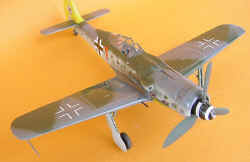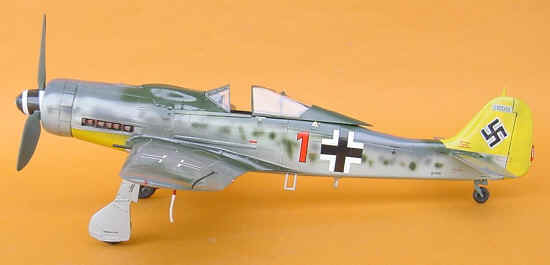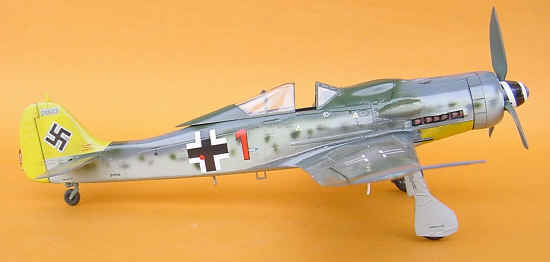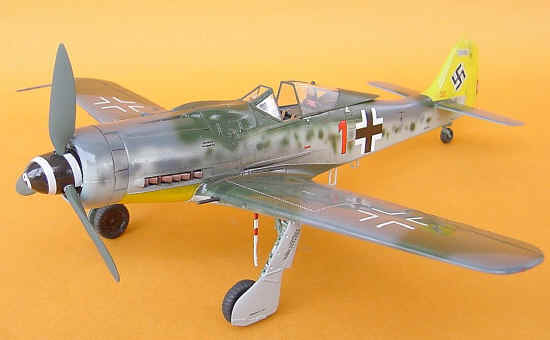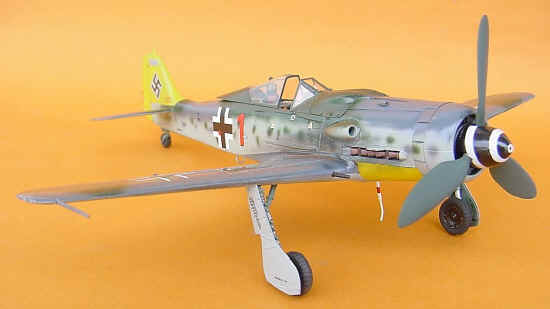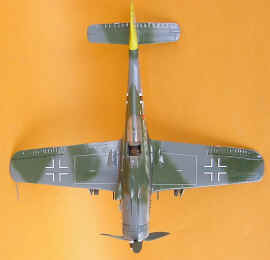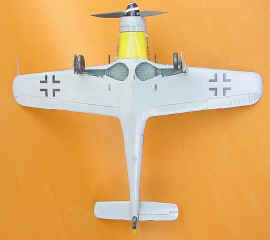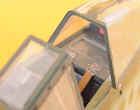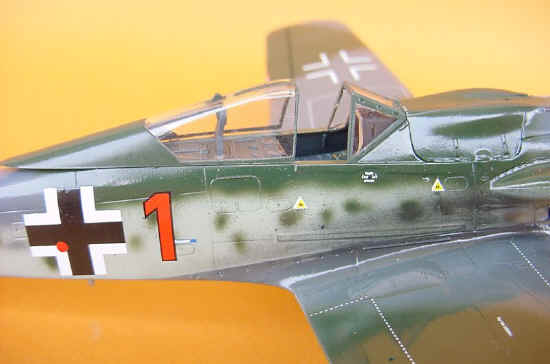|
Legal Notice
No material from Modeler Site any Web site owned, operated, licensed, or controlled by Mario Covalski & Associated may be copied, reproduced, republished, uploaded, posted, transmitted, or distributed in any way, except that you may download one copy of the materials on any single computer for your personal, non-commercial home use only, provided you keep intact all copyright and other proprietary notices. Modification of the materials or use of the materials for any other purpose is a violation of Mario Covalski & Associated's copyright and other proprietary rights.
Read More here > Legal notice
In May 1942, the Luftwaffe asked Messerschmitt and Focke Wulf to design a high altitude fighter. Tank's answer was the Ta152, a much more refined and longer span plane. But while they were working on the development of the engine and plane, and due to the desperate situation the German Air Force was facing, an interim plane was presented: the long nosed FW190, with the Junkers Jumo 213 A in line engine.
To compensate for the excess of weight of the new engine, a 50 cm plug was added to the fuselage, close to the tail. As the Jumo was an engine used in bombers, the fighter pilots did not like it at first.
But soon the maneuverability and power for the new plane won the affection of the pilots, as performance above 10000 ft was very good, speed was 40 to 50 km/hr higher than the previous 190 models, and it was not necessary to diminish the speed to make a tight turn. Weaponry was a little bit lighter than with the FW A 8 and 9, and the rate of roll was not as good as before.
The plane turned out to be so good that the Russians used captured Langnasens to fight against the very Luftwaffe during the last weeks of WWII. Without taking into account the Ta152, it can be said that the FW190 D series was the best piston engined fighter in service in the Luftwaffe.
The Long Nose in service with III/JG 54 - Dortenmann
We will only talk about the planes flown by the Gruppe Dortenmann was a member of. After the onslaught in Normady, where the Luftwaffe lost almost every single plane and pilot involved in the area (75 % of the pilots sent were lost in two weeks), III/JG 54 was deployed at Oldendorf, Germany, to leave their old Antons 8 and 9, rest and refit with the new plane. It's commander was Hptm. Weiss and the leaders in September 1944 where:
9. Staffel: Obtl. Heilmann
10. Staffel: Obtl. Teumer
11. Staffel: Hptm. Botländer
12. Staffel: Obtl. Dortenmann
|
Hans Dortemann was a very experienced pilot, who had already won 20 victories in both fronts since 1942. He personally chose his FW at Rechlin at the beginning of September. It was the 3rd FW190 D9 delivered to the Luftwaffe. All the planes of the StaffelKapitanes of III/JG 54 had the tail painted in yellow to help identification of the leaders by their young and inexperienced pilots during combat.
|
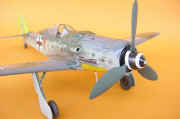
|
Dortenmanns's Werk Number 210003 was RED 1 since the moment it was delivered until Feb 1945, when only the rudder remained painted yellow and the number was changed to BLACK. In 1944, to make planes 10 to 15 km/hr faster, the ground crews polished all the surfaces with floor wax .
After a brief training, 9. and 12. Staffeln were sent to give cover to the take offs and landings of Kommando Nowotny (Me 262).
Dortenmann's first victim was a B-17 of 447th Bomber Group (November 2nd, 1944).
From the end of December till February 1945, III/JG54 was moved to Varrelbusch to protect the Arado 234 base (jet bombers). On January 1st, they took part in operation Bondenplatte, attacking the allied fighter base at Brimbergen, close to Brussels.
Operatively subordinated to JG26 Schlageter, on February 25th III/JG 54 officially became IV/JG 26. This decision was not liked by the pilots, who still referred themselves as members of JG 54.
One external change made to the planes was the addition of the Defense of the Reich bands, in this case, black and white. Staffeln were also changed, and Dortenmann's 11/JG 54 was now 14/JG 26. Therefore, the identification numbers of the planes was changed from yellow to black. 210003 was now BLACK 1.
Dortenmann was very cherished by his inexperienced pilots (most of the new German pilots did not survive their first missions), because he was always protecting them in combat and would not expose them to unnecessary risks.
Due to the unclear and almost coward behavior of Major Klemm, now leader of IV/JG 26, the relationship between both leaders was explosive. As a consequence, Dortenmann complained several times to his superiors. Nevertheless, On March 29th was moved from his 14/JG 26 to 3/JG 26 under command of Major Karl Borris. The decision was made by the Kommodore of JG 26, Major Franz Götz. Klemm remained at his command.
One inexperienced pilot of 14/JG 26 said at that moment:
"Dortenmann was my guarantee of surviving the war in one piece. His mission tactics, his absolute superiority as unit leader, and the fact that he never scored a victory at the cost of his wingman made him stand out" f (1)
Dortenmann farewell
"I flew a wide circle around the field, and dove toward my dispersal in order to waggle my wings. But then an indescribable fireworks display went up in front of me. Flare after flare, radishes, smoke signals. Over the airfield there were lights and flashes in every color" (1)
Germans troops, always going back, fought desperately without success to stop the Allies. Nevertheless, Dortenmann kept on flying and scoring, even in missions in the Berlin area, where flew against the Russians.
Finally, on May 5th, 1945 Dortenmann blew up his trusty crate at Flensburg-Weiche to prevent it from falling into Allied hands. Ceasefire had been issued by Keitel, of the German Army.
It`s important to mention that, in an era when German planes did not last more than one or two weeks, Wk. Nr 210003 survived more than 6 months of combat, only to be destroyed by his pilot.
Dortenmann's victories with 210003
|
III/JG 54
|
IV/JG26
|
I/JG 26
|
|
Date
|
Víctim
|
Date
|
Víctim
|
Date
|
Víctim
|
2/11/44
6/11/44
7/11/44t
29/12/44
13/02/45
21/02/45
22/02/45
|
B-17
P-51
Tempest
Spitfire
2 Spitfires
P-51
P-51
|
19/03/45
28/03/45
|
2 P-51s
Tempest
|
31/03/45
12/04/45
17/04/45
21/04/45
26/04/45
27/04/45
|
Auster
2 Tempests
Tempest
Spitfire
Yak-9
Yak-3
|
TOTAL with FW 190 D-9: 18 victories
Grand TOTAL of the war: 38 victories
|
The kit
I used the Tamiya kit, basicaly Out of the Box. It`s almos a Shake and Make kit, but with some little errors that I did not correct: the spinner is too small, it has not the gear down indicators over the wings, the main landing gear is short and it's covers don't have the right shape.
|
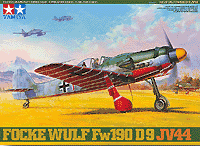
|
The only thing that I added to the kit are the seat arness (photoetched by Eduard 48-290)
As for the paint, I first gave it a hand of yellow to the tail and under the nose, then I masked these areas leaving a small "window" for the area where the Werk Number goes, and sprayed the light grey to the undersurfaces and sides of the fuselage and tail.
Then I painted the dark grey and dark green of the camouflage.
After a hand of gloss varnish, I used the Eagle Decals EC 21, except for the stencils that came from the kit.
To represent the wax applied to this plane, I sealed the decals with gloss varnish again. The decal of the spinner is also included in the Eagle Decals sheet.
I used the following paints
|
RLM
|
Paint
|
04
76
75
83
|
Model Master FS 13538
Model Master FS 16473
Model Master FS 36118
Model Master FS 34079 o Humbrol 116
|
This plane was probably painted again in RLM76, 82 and 83, while RED 1 was replaced by BLACK 1 and the fuselage Defense of the Reich bands.
Sources
(1) Green Herts, First in combat with the Dora 9, Axel Urganke, Eagle Editions. Probably, the best and more detailed book I have ever read about a combat unit. Highly commended.
 FW 190 in Combat, Dr. Alfred Price, Sutton FW 190 in Combat, Dr. Alfred Price, Sutton
 FW 190 D9 Walk Around, Ryle, Squadron FW 190 D9 Walk Around, Ryle, Squadron
 FW 190 aces on the Western Front, John Weal, Osprey FW 190 aces on the Western Front, John Weal, Osprey
Support us ordering our notes in PDF > Here
|

